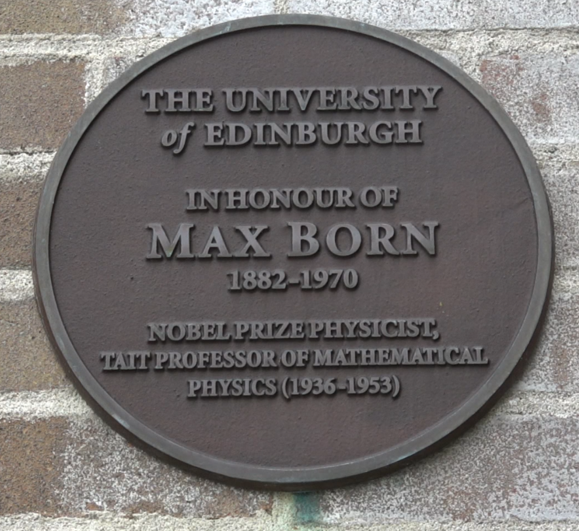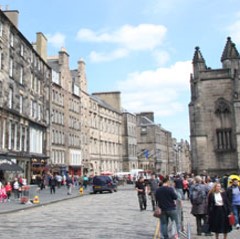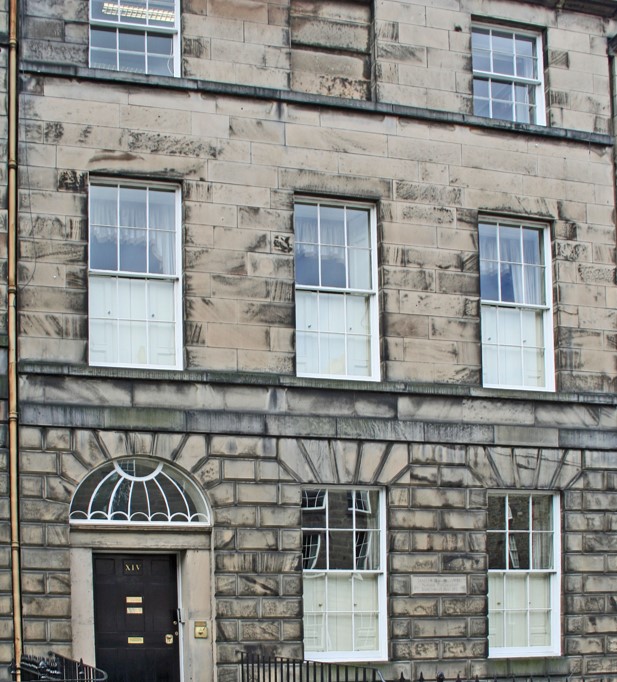Higgs Alumni Tour of Edinburgh
James Clerk Maxwell Building

But it turns out that all over Edinburgh there are many other spots that have some connection with our physics studies.
Join us to (re)discover some of the most notable places for physics in Edinburgh with our planned alumni tour!
Plan of the Tour
- University of Edinburgh Old College
- Peter Higgs plaque
- Peter Higgs hands
- Site of the Luckenbooths
- City Observatory
- James Clerk Maxwell statue
- The Royal Society of Edinburgh
- Mary Somerville’s house
- Birthplace of James Clerk Maxwell
Old College
The University of Edinburgh was first established on this site in 1582. Unusually, it was founded by the town council of Edinburgh and most of its professorial chairs remained in the gift of the council until the reforms brought in by the Universities (Scotland) Act in 1858. Work on the building we see now was started in 1789 and it was more or less completed by 1827. The original design was by Robert Adam. Adam died in 1792 and the building was completed by William Henry Playfair. The dome was only added in 1887.
Peter Higgs Plaque
Peter Higgs is famous for predicting the existence of a new fundamental subatomic particle, now named in his honour the ‘Higgs boson’, while a Lecturer at the Tait Institute of Mathematical Physics in Edinburgh. Its existence solves the problem of why electrons and quarks have mass. He predicted its existence in 1964 in a paper written in a flat at 5 Roxburgh Street. However, it was not until 2012 that it was confirmed that it existed by the Large Hadron Collider, the world’s largest scientific instrument, near Geneva. This discovery earned Higgs the Nobel Prize for Physics.
Peter Higgs Hands
Prof. Peter Higgs was awarded the Edinburgh Award in 2011. This award is awarded to citizens of Edinburgh for their outstanding contribution to the city. The recipient receives an engraved Loving Cup, and has moulds of their hands installed in the City Chambers quadrangle. They appear in groups of four, and Prof. Higgs’ hands are part of the second group as you enter from the Royal Mile. There you will also find the hands of many other famous faces including Sir Chris Hoy, Ian Rankin and JK Rowling. You can view a video of Peter’s reaction to receiving the award (which took place before the Higgs boson was discovered) by clicking here.

Site of the Luckenbooths
In the centre of the High Street close to this spot in the 17th century stood the so-called ‘luckenbooths’. In one of these was the family home of John Keill. Keill deserves the blame for inspiring the acrimonious priority dispute between Sir Isaac Newton and Gottfried Leibniz over the invention of the calculus. In 1701 he accused Leibniz of taken Newton’s unpublished work on ‘fluxions’ and publishing it as his own, calling them ‘differentials’. Newton was convinced by Keill of Leibniz’s plagiarism and so began a long and bitter dispute between them and their followers.

City Observatory
An observatory on Calton Hill was first proposed by Colin Maclaurin, Edinburgh’s professor of mathematics, in 1736. However, these plans came to nothing until Thomas Short brought a 12-foot reflecting telescope to the city in 1776, with the intention of opening a public observatory as a commercial enterprise. The university helped him with the cost of building the observatory on condition it was open to students. Short’s observatory became the property of the city on his death, but his daughter Maria Theresa ran her own observatory on Calton Hill before moving to a new site on Castlehill in 1850. Today, the site is run by the Collective, a centre for contemporary art. For more information, see here.
James Clerk Maxwell Statue
This imposing statue of James Clerk Maxwell was unveiled in Nov 2008. It was sculpted by Alexander Stoddart, Her Majesty’s Sculptor in Ordinary in Scotland. Clerk Maxwell profoundly shaped the development of physics in the 1800s. His most-recognised achievement was to unify light, electricity and magnetism, but he also made contributions in mathematics, astronomy and engineering. He is depicted here along with his dog Toby. He is holding a colour-top, which is a device he used to show that any colour can be produced from red, blue and green. The bronze panels on the side of the statue depict Newton’s experiments with light and prisms and Einstein holding a rubber-mat model of warped space-time. A more-detailed description of the statue can be found here.
The Royal Society of Edinburgh
The Royal Society of Edinburgh was set up in imitation of the Royal Society of London in 1783. It has been at its present location since 1909, having originally met in the college library of the University of Edinburgh. Its fellows have included such illustrious names as James Clerk Maxwell, Roderick Murchison, James Watt and Sir Walter Scott, who was its third president. Although originally scientific in orientation, it now accepts many famous names from the arts and humanities. The Society still continues its work of promoting original research in Scotland today.
Mary Somerville’s House
Mary Somerville (1780-1872) is often described as the “queen of science in the 19th Century.” A writer and polymath, she wrote the ground-breaking interdisciplinary book On the Connexion of the Physical Sciences (1834), combining the latest scientific advances in astronomy, physics, chemistry, botany, and geology. Though she wrote extensively on a variety of subjects and was the first person referenced as a “scientist” (in a review of her work in 1834), it is her contribution to Astronomy that is particularly notable: Mary Somerville was one of the first people to propose the existence of planet Neptune. She was also one of the first two women to be elected members of the Royal Astronomical Society (1835) and co-signatory of John Stuart Mill’s 1866 petition to Parliament to give women the right to vote. Born in Jedburgh in the Borders and growing up in Burntisland, Fife, Mary Somerville lived at 53 Northumberland Street between 1813-16.

James Clerk Maxwell Building II
Now home to a museum of his life and work, this was the childhood home of James Clerk Maxwell, famous for his revolutionary work on electromagnetism and the kinetic theory of gases. Maxwell was born here in 1831. His A Dynamical Theory of the Electromagnetic Field (1865) demonstrated that both electric and magnetic fields and light travel through space as waves at the speed of light. This work laid the foundations for the invention of the radio. Clerk Maxwell’s was perhaps the most important contribution to theoretical physics between Newton and Einstein.The house is now owned by the James Clerk Maxwell Foundation and may be visited by appointment.

With many thanks to Curious Edinburgh (app available via Android and Apple) as most information has been collated from their General Science, History of Physics and History of Astronomy Tours, where you can find even more sites to visit!


Find us on social media:
TwitterFacebookYouTube